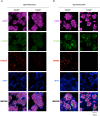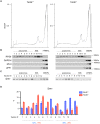Chromatoid Body Protein TDRD6 Supports Long 3' UTR Triggered Nonsense Mediated mRNA Decay
- PMID: 27149095
- PMCID: PMC4858158
- DOI: 10.1371/journal.pgen.1005857
Chromatoid Body Protein TDRD6 Supports Long 3' UTR Triggered Nonsense Mediated mRNA Decay
Abstract
Chromatoid bodies (CBs) are spermiogenesis-specific organelles of largely unknown function. CBs harbor various RNA species, RNA-associated proteins and proteins of the tudor domain family like TDRD6, which is required for a proper CB architecture. Proteome analysis of purified CBs revealed components of the nonsense-mediated mRNA decay (NMD) machinery including UPF1. TDRD6 is essential for UPF1 localization to CBs, for UPF1-UPF2 and UPF1-MVH interactions. Upon removal of TDRD6, the association of several mRNAs with UPF1 and UPF2 is disturbed, and the long 3' UTR-stimulated but not the downstream exon-exon junction triggered pathway of NMD is impaired. Reduced association of the long 3' UTR mRNAs with UPF1 and UPF2 correlates with increased stability and enhanced translational activity. Thus, we identified TDRD6 within CBs as required for mRNA degradation, specifically the extended 3' UTR-triggered NMD pathway, and provide evidence for the requirement of NMD in spermiogenesis. This function depends on TDRD6-promoted assembly of mRNA and decay enzymes in CBs.
Conflict of interest statement
The authors have declared that no competing interests exist.
Figures








Comment in
-
Spermatogenesis Studies Reveal a Distinct Nonsense-Mediated mRNA Decay (NMD) Mechanism for mRNAs with Long 3'UTRs.PLoS Genet. 2016 May 5;12(5):e1005979. doi: 10.1371/journal.pgen.1005979. eCollection 2016 May. PLoS Genet. 2016. PMID: 27149371 Free PMC article. No abstract available.
Similar articles
-
Nonsense in the testis: multiple roles for nonsense-mediated decay revealed in male reproduction.Biol Reprod. 2017 May 1;96(5):939-947. doi: 10.1093/biolre/iox033. Biol Reprod. 2017. PMID: 28444146 Free PMC article. Review.
-
Tdrd6 is required for spermiogenesis, chromatoid body architecture, and regulation of miRNA expression.Curr Biol. 2009 Apr 28;19(8):630-9. doi: 10.1016/j.cub.2009.02.047. Epub 2009 Apr 2. Curr Biol. 2009. PMID: 19345099 Free PMC article.
-
UPF2-Dependent Nonsense-Mediated mRNA Decay Pathway Is Essential for Spermatogenesis by Selectively Eliminating Longer 3'UTR Transcripts.PLoS Genet. 2016 May 5;12(5):e1005863. doi: 10.1371/journal.pgen.1005863. eCollection 2016 May. PLoS Genet. 2016. PMID: 27149259 Free PMC article.
-
Upf1/Upf2 regulation of 3' untranslated region splice variants of AUF1 links nonsense-mediated and A+U-rich element-mediated mRNA decay.Mol Cell Biol. 2006 Dec;26(23):8743-54. doi: 10.1128/MCB.02251-05. Epub 2006 Sep 25. Mol Cell Biol. 2006. PMID: 17000771 Free PMC article.
-
Execution of nonsense-mediated mRNA decay: what defines a substrate?Curr Opin Cell Biol. 2009 Jun;21(3):394-402. doi: 10.1016/j.ceb.2009.02.007. Epub 2009 Apr 7. Curr Opin Cell Biol. 2009. PMID: 19359157 Review.
Cited by
-
Biological and RNA regulatory function of MOV10 in mammalian germ cells.BMC Biol. 2019 May 14;17(1):39. doi: 10.1186/s12915-019-0659-z. BMC Biol. 2019. PMID: 31088452 Free PMC article.
-
Mitochondria Associated Germinal Structures in Spermatogenesis: piRNA Pathway Regulation and Beyond.Cells. 2020 Feb 10;9(2):399. doi: 10.3390/cells9020399. Cells. 2020. PMID: 32050598 Free PMC article. Review.
-
RNA surveillance via nonsense-mediated mRNA decay is crucial for longevity in daf-2/insulin/IGF-1 mutant C. elegans.Nat Commun. 2017 Mar 9;8:14749. doi: 10.1038/ncomms14749. Nat Commun. 2017. PMID: 28276441 Free PMC article.
-
Stress decreases spermatozoa quality and induces molecular alterations in zebrafish progeny.BMC Biol. 2023 Apr 3;21(1):70. doi: 10.1186/s12915-023-01570-w. BMC Biol. 2023. PMID: 37013516 Free PMC article.
-
Nonsense-mediated mRNA decay: a 'nonsense' pathway makes sense in stem cell biology.Nucleic Acids Res. 2018 Feb 16;46(3):1038-1051. doi: 10.1093/nar/gkx1272. Nucleic Acids Res. 2018. PMID: 29272451 Free PMC article. Review.
References
-
- Chalmel F, Lardenois A, Primig M (2007) Toward understanding the core meiotic transcriptome in mammals and its implications for somatic cancer. Ann N Y Acad Sci 1120: 1–15. - PubMed
Publication types
MeSH terms
Substances
LinkOut - more resources
Full Text Sources
Other Literature Sources
Molecular Biology Databases

